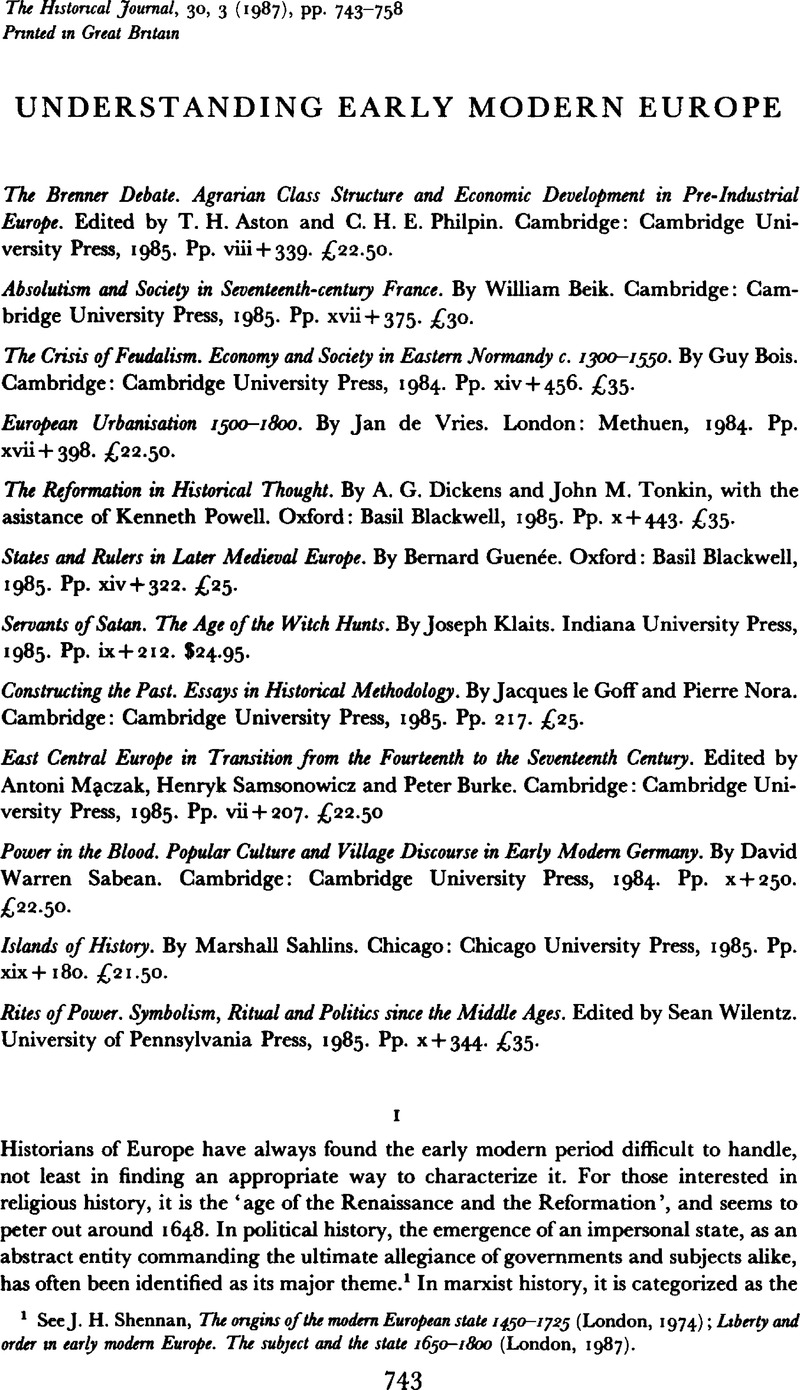No CrossRef data available.
Article contents
Understanding Early Modern Europe
Published online by Cambridge University Press: 11 February 2009
Abstract

- Type
- Review Articles
- Information
- Copyright
- Copyright © Cambridge University Press 1987
References
1 See Shennan, J. H., The origins of the modem European state 1450–1725 (London, 1974)Google Scholar; Liberty and order in early modern Europe. The subject and the state 1650–1800 (London, 1987)Google Scholar.
2 See Holton, R. J., The transition from feudalism to capitalism (London, 1985)CrossRefGoogle Scholar for the most recent critique of this notion.
3 See, for example, the survey article by van Dülmen, Richard, ‘Formierung der europ7auml;ischen Gesellschaft in der Frühen Neuzeit’ Geschichte und Gesellschaft, VII (1981), 1–41Google Scholar, where it is asserted (p. 1) that ‘the development of the “modern”, as it developed since the sixteenth century, is one of the central problems of research on the early modern period’; and see p. 10 ff on the Reformation's role in this process. Schilling, Heinz, ‘Die Geschichte der nordlichen Niederlande und die Modernisierungtheorie’, Geschichte und Gesellschaft, VII (1982), 475–517Google Scholar is sceptical of the direct application of ‘modernisation theory’ to the early modern period, but still accepts a modified framework of the same kind.
4 See Abel, Wilhelm, Agricultural fluctuations in Europe from the thirteenth to the twentieth centimes (London, 1980)Google Scholar, first published in German 1966; Blickle, Peter, Die Revolution von 1525 (Munich, 1975)Google Scholar; Sabean, D. W., Landbesttz und Gesellschqft am Vorabend des Bauemkriegs (Stuttgart, 1972)CrossRefGoogle Scholar; Ulbrich, Claudia, Leibherrschqft am Oberrhem tm Spatmittelalter (Gottingen, 1979)Google Scholar; Kula, Witold, An economic theory of the feudal system. Towards a model of the Polish economy 1500–1800 (London, 1976)Google Scholar, first published in Polish 1962 and in French 1970; Stahl, Henri, Traditional Romanian village communities. The transition from the communal to the capitalist mode of production m the Danube region (Cambridge, 1980)Google Scholar, first published in French in 1969; Smith, R E. F., Peasant farming m Muscovy (Cambridge, 1977)CrossRefGoogle Scholar.
5 Rebel, Hermann, Peasant classes. The bureaucratization of property and family relations under early Habsburg absolution 1511–1636 (Princeton, 1983)CrossRefGoogle Scholar.
6 Kollman, Nancy Shields, Kinship and politics. The making of the Muscovite political system, 1345–1547 (Stanford, 1987)Google Scholar.
7 See Grigg, D. B., Population growth and agrarian change (Cambridge, 1980)Google Scholar, and the dynamics of agrarian change (London, 1982)Google Scholar; and Boserup, Ester, Population and technology (Oxford, 1982)Google Scholar.
8 Goubert, Pierre, Beauvais et le Beauvaises de 1600 à 1730 (2 vols., Paris, 1960)Google Scholar.
9 See Roper, Lyndal, ‘“The common man”, “the common good”, “common women”: gender and meaning in the German reformation commune’, Social History, XII, I (1987), 1–21CrossRefGoogle Scholar.
10 See Scribner, R. W., ‘Sorcery, superstition and society: the witch of Urach, 1529’, Popular culture and popular movements in reformation Germany (London, 1987), pp. 257—76Google Scholar.
11 See Behringer, Wolfgang, ‘Scheiternde Hexenprozesse. Volksglaube und Hexenverfolgung um 1600 in Munchen’, in van Dülmen, Richard, ed., Kultur der einfachen Leute (Munich, 1983), pp.42–78Google Scholar.




